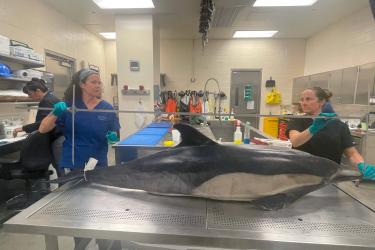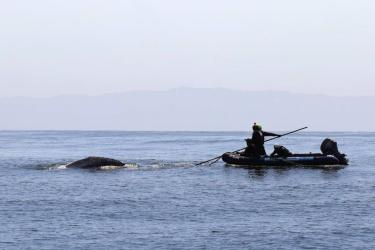The California Current Ecosystem Survey (CCES), also referred to as the CPS survey, is an acoustic-trawl method (ATM) survey conducted annually by the Fisheries Resources Division at NOAA’s Southwest Fisheries Science Center.
In an ever-changing environment, NOAA researchers utilize this survey to monitor changes in the distributions and biomasses of Coastal Pelagic Species, particularly the northern and central sub-populations of Northern Anchovy, the northern subpopulation of Pacific Sardine, Jack Mackerel, Pacific Mackerel, Pacific Herring, their prey, and their biotic and abiotic environments in the California Current Ecosystem. The secondary objectives are to investigate the distributions and abundances of Pacific Whiting, krill, and mesopelagic fishes.
The CCE survey typically occurs during the summer (July-September) and spans the continental shelf off the West Coast of the U.S. and Canada. During the day, sampling is performed along transects using multifrequency scientific echosounders, a continuous underway fish egg sampler (CUFES), and an underway conductivity-temperature-depth (UCTD) probe. At night, surface trawls are conducted in locations where coastal pelagic species were observed acoustically during the day. The trawls serve to estimate the species composition and demographics of the fishes sampled acoustically during the day. These data are used to estimate the abundance of Pacific sardine, Jack mackerel, Pacific mackerel, Northern anchovy, and Pacific herring in the California Current.
In recent years, sampling from NOAA ships has been augmented with acoustic sampling by unmanned surface vehicles (Saildrone USVs), and with acoustic and purse-seine sampling from industry fishing vessels off WA, OR, and CA. The sampling from fishing vessels expands the survey into areas that are inhabited by CPS but are too shallow for the NOAA ships to safely navigate.
In 2021, the survey area was expanded south of the U.S.-Mexico border as part of a collaborative effort between the U.S. and Mexico. In that year, seven Mexican scientists from INAPESCA sailed aboard NOAA Ship Reuben Lasker to survey these transboundary CPS stocks in Mexican waters for the first time since the 1960s.
In collaboration with scientists from the NWFSC and DFO-Canada, the survey continues to evolve and will soon become the Integrated West Coast Pelagics Survey. More information about this integrated survey effort can be found at the Integrated West Coast Pelagics Survey.
More information on the CCES can be found in the Report on the Summer 2021 California Current Ecosystem Survey and biomass estimation from the CCES can be found in the Distribution, Biomass, and Demographics of Coastal Pelagic Fishes in the California Current Ecosystem During Summer 2021 Based on Acoustic-Trawl Sampling.





